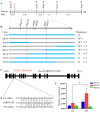Characterization and Mapping of a Rolling Leaf Mutant Allele rlT73 on Chromosome 1BL of Wheat
- PMID: 38612912
- PMCID: PMC11012251
- DOI: 10.3390/ijms25074103
Characterization and Mapping of a Rolling Leaf Mutant Allele rlT73 on Chromosome 1BL of Wheat
Abstract
Leaf rolling is regarded as an important morphological trait in wheat breeding. Moderate leaf rolling is helpful to keep leaves upright and improve the photosynthesis of plants, leading to increased yield. However, studies on the identification of genomic regions/genes associated with rolling leaf have been reported less frequently in wheat. In this study, a rolling leaf mutant, T73, which has paired spikelets, dwarfism, and delayed heading traits, was obtained from a common wheat landrace through ethyl methanesulfonate mutagenesis. The rlT73 mutation caused an increase in the number of epidermal cells on the abaxial side and the shrinkage of bulliform cells on the adaxial side, leading to an adaxially rolling leaf phenotype. Genetic analysis showed that the rolling leaf phenotype was controlled by a single recessive gene. Further Wheat55K single nucleotide polymorphism array-based bulked segregant analysis and molecular marker mapping delimited rlT73 to a physical interval of 300.29-318.33 Mb on the chromosome arm 1BL in the Chinese Spring genome. We show that a point mutation at the miRNA165/166 binding site of the HD zipper class III transcription factor on 1BL altered its transcriptional level, which may be responsible for the rolling leaf phenotype. Our results suggest the important role of rlT73 in regulating wheat leaf development and the potential of miRNA-based gene regulation for crop trait improvement.
Keywords: HD zipper class III transcription factor; miRNA; rolling leaf; wheat.
Conflict of interest statement
The authors declare no conflicts of interest.
Figures




Similar articles
-
Functional mutation allele mining of plant architecture and yield-related agronomic traits and characterization of their effects in wheat.BMC Genet. 2019 Dec 30;20(1):102. doi: 10.1186/s12863-019-0804-2. BMC Genet. 2019. PMID: 31888475 Free PMC article.
-
A mutation in class III homeodomain-leucine zipper (HD-ZIP III) transcription factor results in curly leaf (cul) in cucumber (Cucumis sativus L.).Theor Appl Genet. 2019 Jan;132(1):113-123. doi: 10.1007/s00122-018-3198-z. Epub 2018 Oct 17. Theor Appl Genet. 2019. PMID: 30334067 Review.
-
A Locus Controlling Leaf Rolling Degree in Wheat under Drought Stress Identified by Bulked Segregant Analysis.Plants (Basel). 2022 Aug 9;11(16):2076. doi: 10.3390/plants11162076. Plants (Basel). 2022. PMID: 36015380 Free PMC article.
-
Semi-rolled leaf1 encodes a putative glycosylphosphatidylinositol-anchored protein and modulates rice leaf rolling by regulating the formation of bulliform cells.Plant Physiol. 2012 Aug;159(4):1488-500. doi: 10.1104/pp.112.199968. Epub 2012 Jun 19. Plant Physiol. 2012. PMID: 22715111 Free PMC article.
-
Quick mapping and characterization of a co-located kernel length and thousand-kernel weight-related QTL in wheat.Theor Appl Genet. 2022 Aug;135(8):2849-2860. doi: 10.1007/s00122-022-04154-4. Epub 2022 Jul 8. Theor Appl Genet. 2022. PMID: 35804167 Review.
References
MeSH terms
Grants and funding
LinkOut - more resources
Full Text Sources
Miscellaneous

